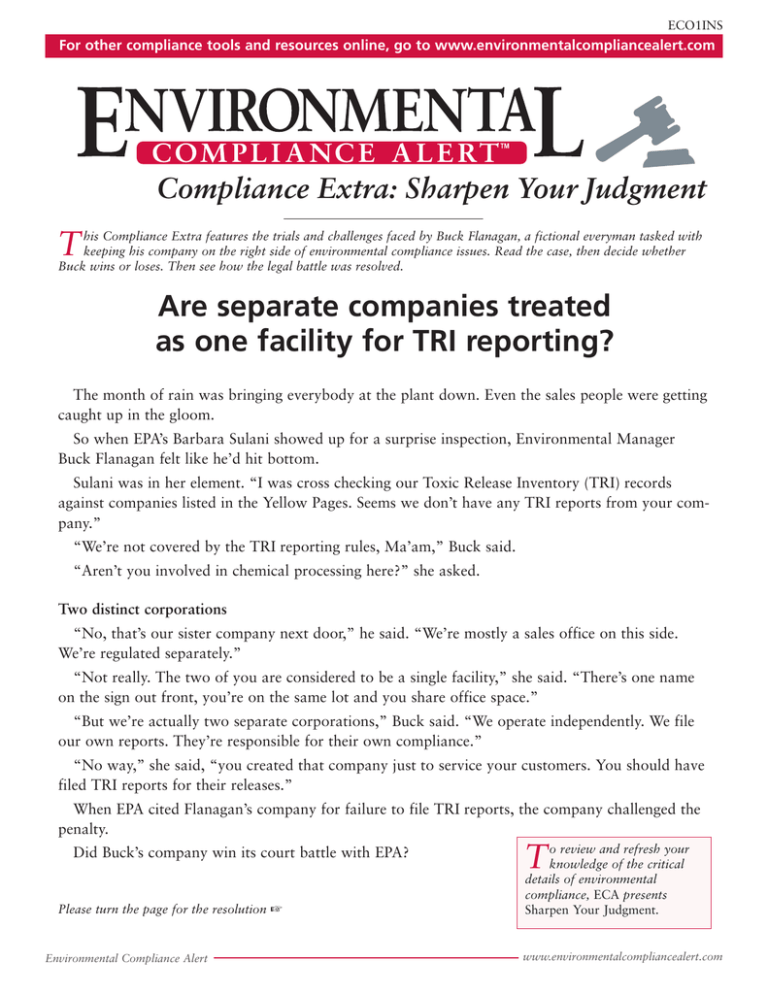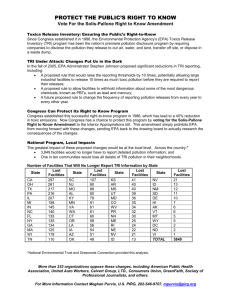Are separate companies treated as one facility for TRI reporting?
advertisement

ECO1INS For other compliance tools and resources online, go to www.environmentalcompliancealert.com Compliance Extra: Sharpen Your Judgment T his Compliance Extra features the trials and challenges faced by Buck Flanagan, a fictional everyman tasked with keeping his company on the right side of environmental compliance issues. Read the case, then decide whether Buck wins or loses. Then see how the legal battle was resolved. Are separate companies treated as one facility for TRI reporting? The month of rain was bringing everybody at the plant down. Even the sales people were getting caught up in the gloom. So when EPA’s Barbara Sulani showed up for a surprise inspection, Environmental Manager Buck Flanagan felt like he’d hit bottom. Sulani was in her element. “I was cross checking our Toxic Release Inventory (TRI) records against companies listed in the Yellow Pages. Seems we don’t have any TRI reports from your company.” “We’re not covered by the TRI reporting rules, Ma’am,” Buck said. “Aren’t you involved in chemical processing here?” she asked. Two distinct corporations “No, that’s our sister company next door,” he said. “We’re mostly a sales office on this side. We’re regulated separately.” “Not really. The two of you are considered to be a single facility,” she said. “There’s one name on the sign out front, you’re on the same lot and you share office space.” “But we’re actually two separate corporations,” Buck said. “We operate independently. We file our own reports. They’re responsible for their own compliance.” “No way,” she said, “you created that company just to service your customers. You should have filed TRI reports for their releases.” When EPA cited Flanagan’s company for failure to file TRI reports, the company challenged the penalty. Did Buck’s company win its court battle with EPA? Please turn the page for the resolution ☞ Environmental Compliance Alert T o review and refresh your knowledge of the critical details of environmental compliance, ECA presents Sharpen Your Judgment. www.environmentalcompliancealert.com TRI Reporting (the resolution) No. Buck’s company should have filed the Toxic Release Inventory (TRI) reports. His company was fined for failing to file the annual Form R reports. The two separate corporations can indeed be considered a single facility as defined by the Emergency Planning and Community Right-to-know Act (EPCRA), the EPA Administrative Appeals Board (EAB) ruled. The board acknowledged that the sales and brokering company wasn’t covered by the TRI regulations because its standard industrial classification (SIC) code is 50. But the sales division was an integral part of the facility’s overall operation and its only real client was the chemical treatment operation, which is clearly within the range of EPCRA-regulated SIC codes – 20 through 39. Citing basic EPCRA rules, the EAB noted that both corporations were next to each other, shared office space, were clearly within the same fenced area and were owned and operated by the same people. EPA inspectors also highlighted that the sign out front of the fenced-in area identified the company as a chemical processing facility. ■LESSON LEARNED: REDUCE RELEASES TO AVOID REPORTING As this case reveals, it’s exceedingly difficult to avoid EPCRA coverage. The best strategy for avoiding EPCRA liabilities is to adopt pollution prevention or waste minimization programs and keep chemical releases and transfers under the law’s reporting thresholds. Legal Cite: In re: Coast Wood Preserving, Inc., (EPA Environmental Appeals Board, EPCRA Appeal No. 02-01). Dramatized for effect. Notes: For more information on the Toxic Release Inventory (TRI) program, visit EPA’s website: http://www.epa.gov/tri/index.htm The legal decision for In re: Coast Wood Preserving, Inc., can be found on the Environmental Appeals Board website: http://tinyurl.com/CoastalWood Environmental Compliance Alert www.environmentalcompliancealert.com



